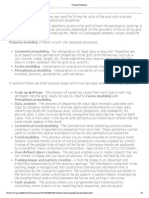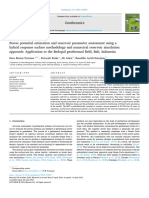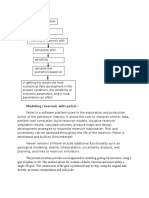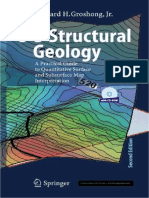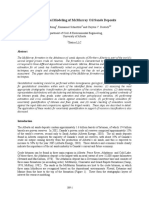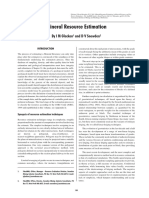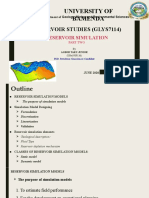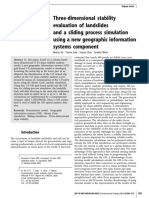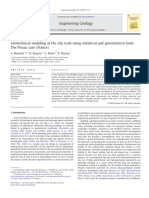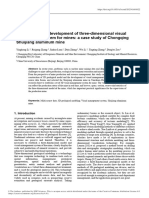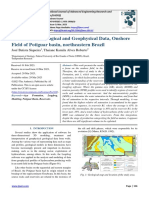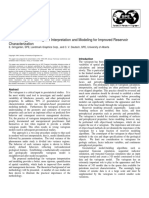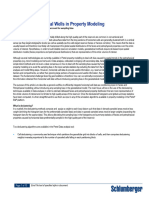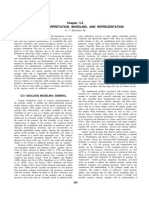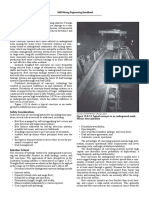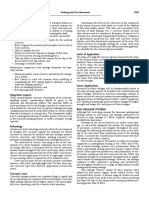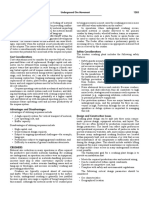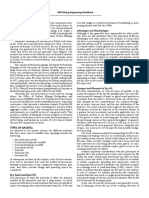Geologic Interpretation, Modeling, and Representation 179
Geologic Interpretation, Modeling, and Representation 179
Uploaded by
YeimsOriginal Description:
Original Title
Copyright
Available Formats
Share this document
Did you find this document useful?
Is this content inappropriate?
Report this DocumentCopyright:
Available Formats
Geologic Interpretation, Modeling, and Representation 179
Geologic Interpretation, Modeling, and Representation 179
Uploaded by
YeimsCopyright:
Available Formats
geologic interpretation, Modeling, and Representation 179
Mineralization and ore-body interpretation developed from data posted on the cross-sectional
base (bottom) in Figure 4.2-3
Alteration interpretation developed from data posted on the cross-sectional base (bottom) in Figure 4.2-3
figure 4.2-4 idealized cross section—alteration and mineralization interpretations
In reality, because of erosion or tectonic events such as limit varied distribution in the geologic resource. The plans
folding and/or faulting, the geologist is commonly working on and sections used to develop the model form the basis for
and evaluating only a portion of a total mineralization system, resource estimation in conventional schemes for calculating
and any model he or she develops from the data should reflect reserves. They provide the input for limiting controls, gen-
this fact. The geologist in turn must recognize the nature and erally as digitized polygons, in computer-assisted method-
complications of this situation and the consequences and ologies and are the primary standard of comparison between
opportunities it presents. conventional and computer-generated resource estimates.
The model provides the limits needed to prevent algorithms
Purpose from estimating resources in unmineralized areas. A well-
The geologic model is constructed to provide a clear picture constructed model ensures that the algorithms are being used
of the 3-D geologic relationship of numerous features that on correlatable units or features.
You might also like
- Property ModelingDocument3 pagesProperty Modelinganby1100% (1)
- 3d Geocellular Modeling 2009Document14 pages3d Geocellular Modeling 2009Adrija ChakrabortyNo ratings yet
- Reservoir Modeling: Types of Reservoir Model Seismic To SimulationDocument5 pagesReservoir Modeling: Types of Reservoir Model Seismic To Simulationhasan fırat AltınyüzükNo ratings yet
- Geological Interpretation For Resource Estimation by John Duke & Pat HannaDocument13 pagesGeological Interpretation For Resource Estimation by John Duke & Pat HannaDadan Saefudin RosidiNo ratings yet
- 02 - Geological Interpretation For Resource Modelling and Estimation - J H Duke and P J HannaDocument10 pages02 - Geological Interpretation For Resource Modelling and Estimation - J H Duke and P J HannaIron Huayhua Chávez100% (1)
- 1 s2.0 S0375650524001093 MainDocument16 pages1 s2.0 S0375650524001093 MainRyan PermanaNo ratings yet
- Chap01 Cawhiv0tDocument31 pagesChap01 Cawhiv0tAndy KristiantoNo ratings yet
- Rapid Geological ModellingDocument9 pagesRapid Geological ModellingFelipe RamirezNo ratings yet
- Modeling Reservoir With PetrelDocument2 pagesModeling Reservoir With PetrelariNo ratings yet
- 3D Reservoir Modeling ProjectsDocument9 pages3D Reservoir Modeling ProjectsBabalola TomisinNo ratings yet
- Leapfrog GeothermalDocument7 pagesLeapfrog GeothermalREandoNo ratings yet
- 3-D Structural GeologyDocument411 pages3-D Structural GeologySuri Sorby RSNo ratings yet
- A Topologically Based Framework For 3-D Basin Modeling: Ulisses T. MelloDocument15 pagesA Topologically Based Framework For 3-D Basin Modeling: Ulisses T. MelloThomas AyeniNo ratings yet
- SPE-170761-MS Structural Uncertainty Integration Within Reservoir Risk Analysis and History MatchingDocument11 pagesSPE-170761-MS Structural Uncertainty Integration Within Reservoir Risk Analysis and History MatchingRiccardo SNo ratings yet
- Log Property Mapping Guided With Seismic AttributesDocument11 pagesLog Property Mapping Guided With Seismic AttributesEdgar GalvanNo ratings yet
- UACE2019 888 GourniaDocument8 pagesUACE2019 888 Gourniagermanytour9No ratings yet
- Dual State-Parameter Estimation of Hydrological Models Using Ensemble Kalman FilterDocument13 pagesDual State-Parameter Estimation of Hydrological Models Using Ensemble Kalman FilterThafer MajeedNo ratings yet
- AssessRiskInGrade TonCurveDocument10 pagesAssessRiskInGrade TonCurvefredNo ratings yet
- 190320210623195955resumo Expandido SBGF2021 FinalDocument6 pages190320210623195955resumo Expandido SBGF2021 Finalrouholah.ahmadi9876No ratings yet
- Iptc 11119 MS PDocument11 pagesIptc 11119 MS PRalf JonesNo ratings yet
- Duke Hanna 2003 Geological Interpretation For Resource Modelling and EstimationDocument10 pagesDuke Hanna 2003 Geological Interpretation For Resource Modelling and EstimationJorge Mauricio LevetNo ratings yet
- Static Model ConstructionDocument10 pagesStatic Model ConstructionAtubrah PrinceNo ratings yet
- SPE 49004 Gradual Deformation of Continuous Geostatistical Models For History MatchingDocument16 pagesSPE 49004 Gradual Deformation of Continuous Geostatistical Models For History MatchingMinh NguyễnNo ratings yet
- Manual Eng in 2Document5 pagesManual Eng in 2Thiago GomesNo ratings yet
- AComparative Studyfor 3 DSurface Modelingof Coal Depositby Spatial Interpolation ApproachesDocument11 pagesAComparative Studyfor 3 DSurface Modelingof Coal Depositby Spatial Interpolation ApproachesLê DuyNo ratings yet
- PCBC TowardIntegrated PDFDocument7 pagesPCBC TowardIntegrated PDFMatias BustamenteNo ratings yet
- Computers and Geotechnics: Francesco BasileDocument10 pagesComputers and Geotechnics: Francesco BasileNaveen KanwatNo ratings yet
- J Cageo 2007 11 005Document14 pagesJ Cageo 2007 11 005Yohannes DeguNo ratings yet
- IPA03-G-173 Geothermal Gunung SalakDocument5 pagesIPA03-G-173 Geothermal Gunung Salakh77hptc6vkNo ratings yet
- 3D Geological Modelling For The Design of Complex Underground WorksDocument10 pages3D Geological Modelling For The Design of Complex Underground WorksHichemNo ratings yet
- An Overview 3-D Geological Modelling Part I-Basics of 3-D Geological ModellingDocument14 pagesAn Overview 3-D Geological Modelling Part I-Basics of 3-D Geological ModellingPawan Kumar AcharyaNo ratings yet
- Integrating Prior Knowledge and Locally Varying Parameters With Moving-Geostatistics: Methodology and Application To Bathymetric MappingDocument11 pagesIntegrating Prior Knowledge and Locally Varying Parameters With Moving-Geostatistics: Methodology and Application To Bathymetric Mappingseyyed81No ratings yet
- Geostatistical Modeling of Mcmurray Oil Sands DepositsDocument10 pagesGeostatistical Modeling of Mcmurray Oil Sands Depositsemilia597No ratings yet
- History Matching Under Training-Image-Based Geological Model ConstraintsDocument9 pagesHistory Matching Under Training-Image-Based Geological Model ConstraintsMinh NguyễnNo ratings yet
- 05 - Mineral Resource Estimation - I M Glacken and D V SnowdenDocument9 pages05 - Mineral Resource Estimation - I M Glacken and D V SnowdenIron Huayhua Chávez100% (1)
- New Developments To Rapidly Delineate 3D Iron Ore Geology and Resource ModelsDocument13 pagesNew Developments To Rapidly Delineate 3D Iron Ore Geology and Resource Modelsi6vj5kpNo ratings yet
- Case History A Unified 3-D Seismic Workflow: Oz Yilmaz, Irfan Tanir, and Cyril GregoryDocument15 pagesCase History A Unified 3-D Seismic Workflow: Oz Yilmaz, Irfan Tanir, and Cyril GregoryamnofispoaNo ratings yet
- Reservoir Simulation Part TwoDocument8 pagesReservoir Simulation Part TwoAgbor taku juniorNo ratings yet
- Hydro-Informatics Methods For Groundwater Simulation-Nastaran ZamaniDocument13 pagesHydro-Informatics Methods For Groundwater Simulation-Nastaran Zamanicopdeposu2071No ratings yet
- TerrSe Geospatial Analysis RCEstoqueDocument31 pagesTerrSe Geospatial Analysis RCEstoqueDiana KairupanNo ratings yet
- ISCSM 2018 KapageridisI - Etal.Document17 pagesISCSM 2018 KapageridisI - Etal.Sondang BerlianNo ratings yet
- Mowen Xie 2003 (3D Slope Stability in A GIS)Document10 pagesMowen Xie 2003 (3D Slope Stability in A GIS)Random Function100% (1)
- Barrera Et Al (2005)Document10 pagesBarrera Et Al (2005)Ulisses Miguel CorreiaNo ratings yet
- Xiaopeng Ma 2022Document13 pagesXiaopeng Ma 2022jamal manssourNo ratings yet
- Geostatistics and Reserve EstimationDocument10 pagesGeostatistics and Reserve EstimationLASER LIONNo ratings yet
- Marache 2009Document10 pagesMarache 2009Malick DemanouNo ratings yet
- Validation of 3d FE Piled RaftDocument15 pagesValidation of 3d FE Piled RaftAndersonNo ratings yet
- Research On The Development of Three-Dimensional VDocument4 pagesResearch On The Development of Three-Dimensional VNtokozo NdalaNo ratings yet
- Modeling of Geological and Geophysical Data, Onshore Field of Potiguar Basin, Northeastern BrazilDocument5 pagesModeling of Geological and Geophysical Data, Onshore Field of Potiguar Basin, Northeastern BrazilIJAERS JOURNALNo ratings yet
- The Application of Photogrammetry To Land Use PlanningDocument7 pagesThe Application of Photogrammetry To Land Use PlanningMar AizawaNo ratings yet
- Hunterrgisc 9216 D 3Document27 pagesHunterrgisc 9216 D 3api-248724607No ratings yet
- Mapping of The Microrelief Structures Using Topographic DataDocument7 pagesMapping of The Microrelief Structures Using Topographic Dataebi18750No ratings yet
- Utilization of Markov Chain Monte Carlo Approach For Calibration and Uncertainty Analysis of Environmental ModelsDocument5 pagesUtilization of Markov Chain Monte Carlo Approach For Calibration and Uncertainty Analysis of Environmental ModelsNanda Azizah Mardotillah45No ratings yet
- 3D Static ModelingDocument6 pages3D Static Modelingbidyut_iitkgpNo ratings yet
- 1 s2.0 S1674987119302282 MainDocument15 pages1 s2.0 S1674987119302282 MainloboclvNo ratings yet
- Accurate Stratigraphic Prediction From Seismic: Matt Hall & Eric Trouillot, Landmark Graphics, Calgary, CanadaDocument8 pagesAccurate Stratigraphic Prediction From Seismic: Matt Hall & Eric Trouillot, Landmark Graphics, Calgary, CanadasaNo ratings yet
- 1999 - Gringarten & Deutsch - Methodology For Variogram Interpretation and Modeling For Improved Reservoir Characterization PDFDocument13 pages1999 - Gringarten & Deutsch - Methodology For Variogram Interpretation and Modeling For Improved Reservoir Characterization PDFsputriNo ratings yet
- Integrating Horizontal Wells in Property ModelingDocument10 pagesIntegrating Horizontal Wells in Property ModelingOscar Javier Vera ZambranoNo ratings yet
- Geologic Interpretation, Modeling, and Representation: A. J. E JDocument11 pagesGeologic Interpretation, Modeling, and Representation: A. J. E JBrunno AndradeNo ratings yet
- Link 3Document1 pageLink 3YeimsNo ratings yet
- Block Caving 1443: Figure 13.10-7 Extraction Level Under Construction Using An Advanced Undercut, Doz Mine, IndonesiaDocument1 pageBlock Caving 1443: Figure 13.10-7 Extraction Level Under Construction Using An Advanced Undercut, Doz Mine, IndonesiaYeimsNo ratings yet
- LinkDocument1 pageLinkYeimsNo ratings yet
- Underground Ore Movement 1287: Integration AspectsDocument1 pageUnderground Ore Movement 1287: Integration AspectsYeimsNo ratings yet
- 260 Sme Mining Engineering Handbook: Volume 5: Operating PlanDocument1 page260 Sme Mining Engineering Handbook: Volume 5: Operating PlanYeimsNo ratings yet
- A Global Perspective On Mining Legislation: Diana DaltonDocument1 pageA Global Perspective On Mining Legislation: Diana DaltonYeimsNo ratings yet
- Conveyors: 1288 Sme Mining Engineering HandbookDocument1 pageConveyors: 1288 Sme Mining Engineering HandbookYeimsNo ratings yet
- Heavy Mineral Separations: Geochemical Prospecting 133Document1 pageHeavy Mineral Separations: Geochemical Prospecting 133YeimsNo ratings yet
- 1284 Sme Mining Engineering Handbook: Drilling Pilot Hole Down Attaching Reamer Reaming UpDocument1 page1284 Sme Mining Engineering Handbook: Drilling Pilot Hole Down Attaching Reamer Reaming UpYeimsNo ratings yet
- Mineral Property Feasibility Studies 235: Volume 2: Project EconomicsDocument1 pageMineral Property Feasibility Studies 235: Volume 2: Project EconomicsYeimsNo ratings yet
- Limits of Application: Underground Ore Movement 1289Document1 pageLimits of Application: Underground Ore Movement 1289YeimsNo ratings yet
- 1286 Sme Mining Engineering Handbook: Figure 12.8-14 Ore-Handling System at Olympic Dam MineDocument1 page1286 Sme Mining Engineering Handbook: Figure 12.8-14 Ore-Handling System at Olympic Dam MineYeimsNo ratings yet
- Cost Considerations Safety Considerations: Underground Ore Movement 1285Document1 pageCost Considerations Safety Considerations: Underground Ore Movement 1285YeimsNo ratings yet
- References: 126 Sme Mining Engineering HandbookDocument1 pageReferences: 126 Sme Mining Engineering HandbookYeimsNo ratings yet
- 104 Sme Mining Engineering Handbook: Type 10Document1 page104 Sme Mining Engineering Handbook: Type 10YeimsNo ratings yet
- 148 Sme Mining Engineering Handbook: SymbolsDocument1 page148 Sme Mining Engineering Handbook: SymbolsYeimsNo ratings yet
- Health and Medical Issues in Global Mining 1575Document1 pageHealth and Medical Issues in Global Mining 1575YeimsNo ratings yet
- 108 Sme Mining Engineering Handbook: Geochemical Analytical MethodsDocument1 page108 Sme Mining Engineering Handbook: Geochemical Analytical MethodsYeimsNo ratings yet
- 1376 Sme Mining Engineering Handbook: Advantages and DisadvantagesDocument1 page1376 Sme Mining Engineering Handbook: Advantages and DisadvantagesYeimsNo ratings yet
- Page 1846 PDFDocument1 pagePage 1846 PDFYeimsNo ratings yet
- Index Terms Links: Next PageDocument1 pageIndex Terms Links: Next PageYeimsNo ratings yet
- 84 Sme Mining Engineering Handbook: Destructive Plate MarginsDocument1 page84 Sme Mining Engineering Handbook: Destructive Plate MarginsYeimsNo ratings yet
- 86 Sme Mining Engineering Handbook: Surface or Seafloor HydrothermalDocument1 page86 Sme Mining Engineering Handbook: Surface or Seafloor HydrothermalYeimsNo ratings yet
- Sub-Subtype 9.2.2.1: Algoma Bif: Geological Features and Genetic Models of Mineral Deposits 97Document1 pageSub-Subtype 9.2.2.1: Algoma Bif: Geological Features and Genetic Models of Mineral Deposits 97YeimsNo ratings yet
- Acknowledgments: 80 Sme Mining Engineering HandbookDocument1 pageAcknowledgments: 80 Sme Mining Engineering HandbookYeimsNo ratings yet
- Investment Analysis 79: Figure 2.4-9 Relative Performance of Australian Dollar Versus CRB IndexDocument1 pageInvestment Analysis 79: Figure 2.4-9 Relative Performance of Australian Dollar Versus CRB IndexYeimsNo ratings yet
- 74 Sme Mining Engineering HandbookDocument1 page74 Sme Mining Engineering HandbookYeimsNo ratings yet
- Valuation of Producing Mining Companies: External Factors Affecting Cash FlowsDocument1 pageValuation of Producing Mining Companies: External Factors Affecting Cash FlowsYeimsNo ratings yet
- 70 Sme Mining Engineering Handbook: Cost of CapitalDocument1 page70 Sme Mining Engineering Handbook: Cost of CapitalYeimsNo ratings yet
- Valuation of Producing Mining Companies: Internal Factors Affecting Cash FlowsDocument1 pageValuation of Producing Mining Companies: Internal Factors Affecting Cash FlowsYeimsNo ratings yet
